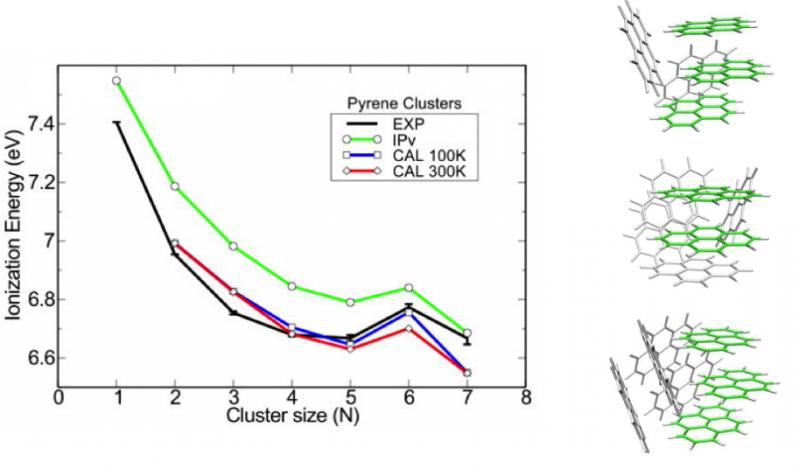Correlation between structures and electronic properties in PAH aggregates
An interdisciplinary French team involving laboratories in Toulouse (IRAP, LCPQ) and the Paris region (Synchrotron SOLEIL, ISMO) combined the measurement of photo-ionization spectra at the SOLEIL synchrotron with molecular simulations and were able to establish the correlation between structures and electronic properties (ionization) of aggregates of hydrogenated polycyclic aromatic molecules (PAH) in the gas phase. The knowledge of these structures will allow a better characterization of the properties of these aggregates, in particular their spectroscopy and stability, in order to advance our understanding of the role of these systems in the chemistry of star-forming regions as well as in flames.
First experimental measurements of photoelectron spectra of PAH aggregates based on C16H10 pyrene and C24H12 coronene were obtained using the coincidence photoelectron-photoion imaging technique available on the far ultraviolet (VUV) DESIRS to SUN photon line. These data were compared with the results of molecular simulations in which structure and temperature effects were taken into account. For an aggregate of typically 6 molecules a number of isomers can be populated at temperatures of 100-200K. The quality of the experimental/simulation agreement allowed to validate the theoretical approach used. The aggregate structures obtained are composed of multiple stacks beyond typically 4 monomers. An important result was to show that, during ionization, the charge is not distributed over the whole aggregate but remains localized on a few molecular units (1 to 3). This behaviour will affect the electronic properties and stability of these systems.

In astrophysical environments, PAHs are produced by destroying very small carbonaceous grains under the effect of VUV photons. The work presented here is a first step in the study of this process, with PAH aggregates being considered as laboratory model systems of these very small cosmic carbonaceous grains. The ionization properties of PAH aggregates (relatively low ionization energy and high ionization cross section efficiency) imply that these species would be largely ionized in environments where PAHs are formed. Their evaporation properties will therefore differ from those of neutral aggregates that have been considered so far in astrophysical models.
This interdisciplinary work (CNRS-INSU/INP/INC) was initiated within the framework of the ANR Gas-phase PAH research for the interstellar medium project (GASPARIM, ANR-10- BLAN-0501) and also involved resources from the ERC Synergy NANOCOSMOS project.
Further Resources
- Size Effect in the Ionization Energy of PAH Clusters, C. Joblin, L. Dontot, G.A. Garcia, F. Spiegelman, M. Rapacioli, L. Nahon, P. Parneix, T. Pino, and P. Bréchignac, Journal of Physical Chemistry Letters 8, 3697–3702 (2017), 25 juillet 2017
IRAP Contact
- Christine Joblin, IRAP (CNRS/Université Paul Sabatier-Toulouse III)
christine.joblin@irap.omp.eu, 05 61 55 86 01






